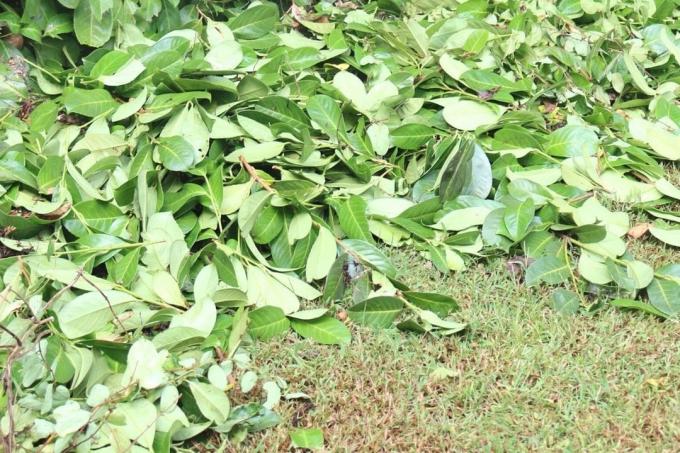
Table of Contents
- No cutting
- Circumference
- Topiary in summer
- Rejuvenation pruning in winter
- Cut in diseases
- frequently asked Questions
Cherry laurel is fast-growing and therefore ideal as a hedge plant. For this, however, the wood must be cut regularly. But when is it forbidden to cut cherry laurel? We clarify and give cutting tips.
In a nutshell
- Cutting back gives shape and ensures strong and dense growth
- At the end of June there is a slight shape cut
- Radical cuts prohibited from March to the end of September
- perform strong prunings at the end of February
- Avoid electric scissors as they can cut leaves unattractively
No cutting
For the laurel cherry (Prunus laurocerasus), as for most hedges, shrubs and woody plants, loud applies Section 39 of the Federal Nature Conservation Act from 1. March to 30th September a cutting ban. During this time, especially for reasons of Bird protection, no radical cuts are made. It is therefore not allowed to “put on the stick” of the trees. However, if you want to cut the cherry laurel to keep it in shape and healthy, this is not forbidden.
Notice: In the case of larger shaped and care cuts, however, you should always contact the responsible nature conservation authority. Violations of this temporal cutting ban result in severe fines of up to 50,000 euros.
Circumference
A cherry laurel that grows as a solitaire and thereby finds enough space for its development does not have to be cut. However, it is possible to specifically shape its crown with cutting measures, for example to cut it into a spherical shape. A hedge made from cherry laurel, on the other hand, cannot do without regular pruning. The annual increase in height of up to 40 cm and the spreading growth cannot otherwise be tamed. In order for young plants to grow vigorously and opaque, the annual new growth must be cut by half in the first years of life.

Tip: If necessary, you can prune back your cherry laurel vigorously without hesitation. The evergreen shrub is very easy on pruning and sprouts out of old wood without any problems.
Topiary in summer
With a shape cut, the crown that has grown out of the shape is cut again in an appealing way. This correction cut should be carried out once a year.
- after completing the first growth spurt
- The end of June is the ideal time
- after flowering and before the start of the St. John's shoot
- ideally an overcast day
- Rain increases the risk of fungal diseases
- Sunshine can cause sunburn
- Cut the hedges narrower towards the top
Specimens that are growing faster can get a topiary again in autumn. However, this pruning measure can severely impair the flowering of the following year or even cause it to fail.
Attention: Cherry laurel is poisonous and its juice can irritate the skin. Therefore, wear gloves and long clothing for all cutting measures.
Rejuvenation pruning in winter
Plants that have grown too large or that have become bald require radical pruning. Individual branches are thinned out so that light can penetrate into the interior of the crown. This measure must be carried out in late winter. Because, as already mentioned, from March to the end of September it is forbidden to radically prune cherry laurel (and other shrubs) so as not to disturb any nesting birds.

An additional, strong pruning in winter is also useful for vigorous varieties:
- Cut in mid to late February
- Choose a frost-free, overcast day
- Remove competing and inward-growing branches
- Shorten the remaining branches
Cut in diseases
The cherry laurel owes its beauty to its glossy green leaves. But no specimen is safe from powdery mildew and shotgun disease. Then it is important to act quickly to save the bush. As a first measure, pruning is recommended.
- do not wait until the scheduled cut date
- Prune the plant immediately
- Generously remove affected leaves and twigs
- Put severely diseased bushes on a stick

The diseased clippings must not be composted. The temperature in domestic compost is too low to reliably destroy pathogens. There is a great risk that they will be spread all over the garden with compost. In addition to diseases, frost can also affect the laurel to clog strongly. This frost damage must be removed with scissors in late winter.
frequently asked Questions
In principle, the cherry laurel can be pruned by hand or with an electric hedge trimmer. The latter, however, often literally divides the large leaves of the wood. The result: The leaf remnants dry up brown on the cut edge and take a long time to recover. So from an aesthetic point of view, you should prefer hand scissors.
Cut greenery from healthy plants can be composted. However, since the fleshy leaves rot very slowly, it is better to put larger quantities in the organic waste bin.
Suitable cuttings for propagation can be cut from clippings that are produced in large quantities during topiary pruning in summer. The green tips are ideally suited as head cuttings. Cracks from two-year-old wood can also be rooted. But be patient, as cherry laurel takes root very slowly.
You can prevent berry formation by carefully removing the faded inflorescences in summer after flowering. With an autumn cut, the berry formation is also prevented, as this removes the blossoms for the following year. Without flowers, no fruit.
